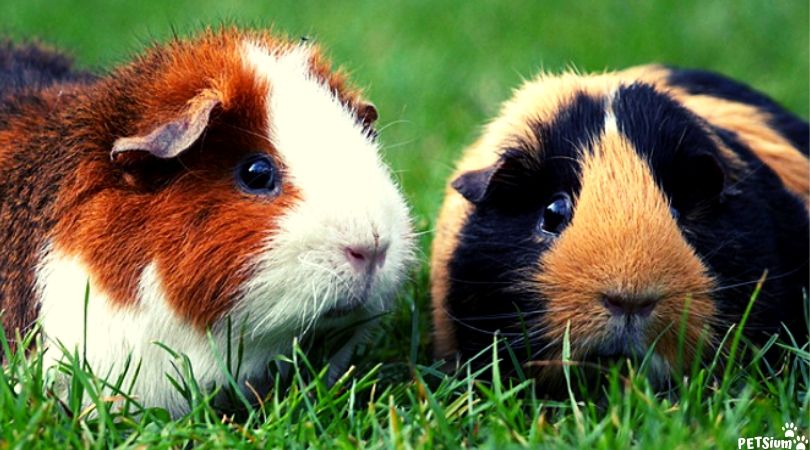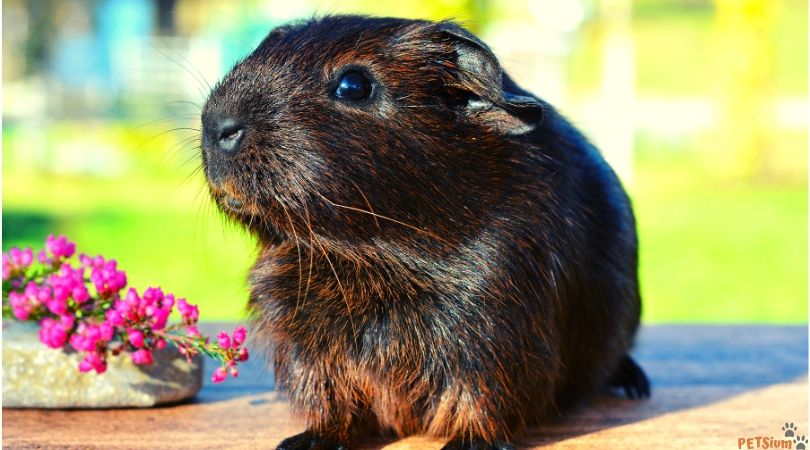The guinea pig, although relatively a healthy animal can get ill and you as a owner should learn about common guinea pig illnesses.
When you have a family pet as loving as the guinea pig, it often entails being the family doctor.
It is vital for all guinea pig owners to be able to supply and treat their guinea pigs with optimal care.
There are many common conditions such as “bumblefoot” to more uncommon conditions such as abortions and stillbirths.
The guinea pig is naturally “alive” and playful in spirit.
It enjoys hide-and-seek, being pampered, and will jump high in the air at times when it is agitated or around a new person, therefore, it is not difficult to distinguish when there is something troubling your guinea pig, such as illness.
Common Guinea Pig Heath Problems Signs
If your guinea pig is experiencing bouts of lethargy, weight loss, discoloration or weakness, it is time to get the medical journal out and put on your nurse’s hat.
These are all signs that the guinea pig health is at risk.
Diet is a very important concern in guinea pig health.
The guinea pig is unable to produce its own vitamin C; therefore it is necessary to ensure that the guinea pig is feed foods with vitamin C.
Signs of Vitamin C Deficiency in Guinea Pigs
Signs of a vitamin C deficiency will include lethargy, lack of movement, weakness, hopping instead of walking, lack of appetite, loss of weight, diarrhea, discharge from the eyes and nose, coarse or rough hair, experiences pain when touched, an internal skeletal-muscular hemorrhage, and /or stiff limb joints.
Ensure that your guinea pig is getting an adequate supply of vitamin C by feeding it a diet of pellets formulated for guinea pigs, fresh vegetables and fruit, and grasses. You can read our „What can Guinea pigs eat“ for details.

Common Guinea Pig Illnesses
Common guinea pig illnesses can strike even with our watchful care.
Prevention of course is important, but it is no guarantee that health problems will not take place.
This is why it is important for us to stay vigilant so we can spot the signs and symptoms of these diseases early on.
There’s nothing more distressing for a pet owner than to see his pet ill.
With cavies, due to their small size, these disease can progress really quickly.
Guinea Pig Illnesses and the Symptoms You May Observe in Your Cavy:
Guinea pigs are usually very active, so if you see something that’s off in their behavior, don’t just brush it off. It may be an early warning of an impending illness.
Common signs of illness include slower movements or generally less activity.
You may also notice guinea pig not eating, eating less or drinking less.
An unusual discharge in any part of the body should be looked into.
Diarrhea is not common, but should be taken seriously when you see it in your pet.
Parasitic and fungal skin infections
Signs that you can observe is a guinea pig that seems to scratch itself a lot.
When you check the cavy’s fur, you will see scratch woulds and scaling.
Parasites and fungal infections can spread quickly.
Be sure to check all your guinea pigs if you suspect that one of them is infected.
Urinary tract infection
Urinary tract infections are common in guinea pigs and their anatomy contributes to this problem.
Guinea pigs are quite „low slung“, especially the older ones.
This puts them in contact with the floor litter and makes them more susceptible to urinary infection.
Aside from this, their diet may also put them at risk for these types of infections.
Having too much calcium in their diet, or perhaps eating too much dry food and not taking sufficient water can also be blamed.
Vitamin C deficiency
Because guinea pigs do not produce their own vitamin C, they need to supply themselves with it from the food that they eat.
A deficiency in this vitamin interferes with energy absorption, which can result to malnutrition, hair loss, susceptibility to respiratory infections and so on.
Respiratory infection
Guinea pigs are prone to allergy from dust, pollen and even to the type of bedding material that you use.
Aside from this, a common bacteria called Bordatella present in our environment can also cause respiratory infection in guinea pigs.
Old age
When your cavy has reached old age, debility is something that you cannot entirely avoid.
Your cavy will be more sluggish and slow in its movements.
One way to avoid complications is to make sure your cavy is healthy and fit in its youth.

Common Guinea Pig Parasites
One of the common afflictions that can affect your guinea pig are parasites.
Guinea pig parasites are a bane to both cavies and their owners.
Parasites can do a lot of harm to your guinea pigs. It causes intense itch, and scratching leads to wounds.
Parasites can also carry infectious diseases with them, and may even cause anemia in severe cases.
Parasites are usually brought in when you have a pet that’s allowed to go outdoors.
Or there may be cases when you unwittingly let parasites in when you introduce a new guinea pig into your home.
This is why we should never skip putting a new guinea pig in quarantine for 2 to 3 weeks to make sure we stop the spread of parasites and other diseases.
Common guinea pig parasites include lice, mites and fleas
Lice
There are several types of lice that can affect guinea pigs.
All of them do not pose any risk to humans. Lice can cause intense itching, scratching, and scabbing.
You will find red papules one back of the head and behind the ears.
Lice infestation are usually together with fleas.
When treating guinea pigs for lice, all guinea pigs and not just the one suspected of having lice will be inspected.
All beddings and housing should be thoroughly cleaned as well.
Fleas
Fleas can also affect guinea pigs.
This usually happens when you have other animals in the house, such as dog and cats, who get infected outside the home.
When they return, the fleas catch a free ride and spread to other animals in the house.
The most common flea that affects guinea pigs are what’s commonly called as cat flea.
Fleas can cause intense itching, hair loss, and crusty lesions on the skin.
If left untreated, it can lead to anemia and even death.
In guinea pigs that are afflicted with fleas, you will be able to observe small brown granules on their fur when you brush it.
These brown granules are the fleas feces, which serves as the food of newly hatched flea larvae.
If you suspect fleas in your guinea pigs, bring them to the vet to find out what the recommended treatment is.
Other pets in the house should also be observed for fleas.
Together with treatment, prepare to do a general cleaning and disinfecting of the spaces occupied by your pets.

Mites
When it comes to mites, there are 2 types of mites that are commonly seen to afflict guinea pigs.
These are the T. caviae and the C. caviae.
Trixacarus caviae mites
This type of mite is transmitted by direct contact and can afflict humans as well.
T. caviae is known to burrow itself into the skin of the host. It is not always active.
In some guinea pigs, the mite can remain dormant and may surface when the animal is weaker such as at times of sickness or poor nutrition.
When active, it causes an itch that is so intense at times that you may observe your pets throwing fits as if they’re having seizures.
You may also see guinea pigs scratching their bodies to the point of creating open wounds, which then opens them up to risks of secondary infections.
These mites cause redness and papules, commonly found around the head, shoulders, on the back and around the flanks of your pets’ body.
Chirodiscoides caviae mites
In a way c.caviae are easier to detect because the mite lives on the hair of the host animal.
In guinea pigs, it is often found on the hairs in the rump area.
This mite is also transmitted by direct contact.
Just like the t.caviae, it causes itching, scratching, hair loss, and redness.

Prevent health issues in guinea pigs
It is a good practice to get into to give your guinea pig a health check every day.
Begin with checking the eyes for discharge.
If you notice a discharge aside from the normal milky discharge that is sometimes produced, it could be a sign of infection, such as conjunctivitis and should be treated.
If you notice a discoloration of the eye, the guinea pig may have scratched his eye on something and likely needs to be examined by the veterinarian, as the protective covering to the eye is likely damaged.
Your guinea pig health checklist should also include a check of the hair and skin.
Run your fingers through the guinea pigs hair and feel for coarseness or brittle hair, pay close attention to the skin as well.
Your guinea pigs skin should be free from scratches, sores and flaky skin.
Pay attention to the itching habits of the guinea pig as well.
Any of these signs could be a sign of a fungal infection, lice or other forms of a skin condition.
Check the ears of your guinea pig each day when performing your guinea pig health checklist.
The ears should be soft and smooth, and not have excessive wax buildup.
Ear conditions will result as a sign of ear mites or infection.
Check the nose for discharge- yes even guinea pigs get colds!
Sinusitis is a condition which will show through a running nose and needs to be treated immediately by your veterinarian.
Check the guinea pig each day for conditions of the feet.
The feet should be free from all swelling, cuts and scrapes.
Weigh the guinea pig weekly to ensure that it is not losing weight.
Weight loss is a sign of an underlying condition in the guinea pig.
Respiratory problems are also another condition that affects the guinea pig.
Check the guinea pig daily for labored breathing or wheezing.